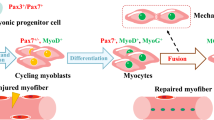Summary
The interpyramidal muscles of the lantern of Diadema setosum have been studied as an example of such muscles in regular echinoids. The light- and electron microscopic study proves that the interpyramidal muscle is nothing but a continuous, highly folded myoepithelium. Although it is a powerful and specialized comminator muscle its histological organization (a pseudostratified myoepithelium) is rather simple when compared with other echinoderm myoepithelia. It consists of only two cell types: 1) a single layer of well-developed myocytes and 2) monociliated adluminal cells that totally cover the myocytes and touch the basal lamina by thin basal processes. The interpyramidal muscle grows by addition of new folds to its upper region. Consecutive stages of the myoepithelial differentiation are found in each of the young folds. The origin of the cells which are necessarily added to the growing epithelium is unknown. The growth rate of the muscle is in accordance with the enlargement of the lantern ossicles. The respective data are discussed in detail.
Similar content being viewed by others
References
Cuénot L (1891) Etudes morphologiques sur les échinodermes. Arch Biol 11:303–680
Hamann O (1887) Beiträge zur Histologie der Echinodermen: Heft 3; Anatomie und Histologie der Echiniden und Spatangiden. Fischer, Jena
Hyman LH (1955) The invertebrates: IV. Echinodermata. McGraw-Hill, New York
Lanzavecchia G, Candia Carnevali MD, Melone G, Celentano FC, Andrietti F (1988) Aristotle's lantern in the regular sea urchin Paracentrotus lividus: I. Functional morphology and significance of bones, muscles and ligaments. In: Burke RD, Mladenov PV, Lambert P, Parsley RL (eds) Echinoderm biology. Balkema, Rotterdam, pp 649–662
Lovén S (1892) Echinologica. Sven Vetensk-Akad Handl 18:1–73 pls 1–12
Märkel K (1976) Das Wachstum der Laterne des Aristoteles und seine Anpassungen an die Funktion der Laterne. Zoomorphologie 86:25–40
Märkel K (1978) On the teeth of the recent cassiduloid Echinolampas depressa Gray, and on some liassic fossil teeth nearly identical in structure. Zoomorphologie 89:125–144
Märkel K (1979) Structure and growth of the cidaroid socket-joint lantern of Aristotle compared to the hinge-joint lanterns of non-cidaroid regular echinoids. Zoomorphologie 94:1–32
Märkel K, Gorny P, Abraham K (1977) Microarchitecture of sea urchin teeth. Fortschr Zool 24:103–114
Märkel K, Röser U, Stauber M (1989) On the ultrastructure and the supposed function of the mineralizing matrix coat of sea urchins. Zoomorphology 109:79–87
Rieger RM, Lombardi J (1987) Ultrastructure of coelomic lining in echinoderm podia: significance for concepts in the evolution of muscle and peritoneal cells. Zoomorphology 107:191–208
Saita A (1969) La morfologia ultrastrutturale dei muscoli della Lanterna di Aristotele di alcuni Echinoidei. Ist Lomb Acad Sci Lett Rend Sci B 103:297–313
Stauber M, Märkel K (1988) Comparative morphology of muscle-skeleton attachments in the Echinodermata. Zoomorphology 108:137–148
Takahashi K (1967) The catch apparatus of the sea urchin spine: I. Gross histology. J Fac Sci Univ Tokyo 11(4):109–120
Wilkie IC (1984) Variable tensility in echinoderm collagenous tissues: a review. Mar Behav Physiol 11:1–34
Wood RL, Cavey MJ (1981) Ultrastructure of the coelomic lining in the podium of the star fish Stylasterias forreri. Cell Tissue Res 218:449–473
Author information
Authors and Affiliations
Rights and permissions
About this article
Cite this article
Märkel, K., Röser, U. & Stauber, M. The interpyramidal muscle of Aristotle's lantern: its myoepithelial structure and its growth (Echinodermata, Echinoida). Zoomorphology 109, 251–262 (1990). https://doi.org/10.1007/BF00312192
Received:
Issue Date:
DOI: https://doi.org/10.1007/BF00312192




